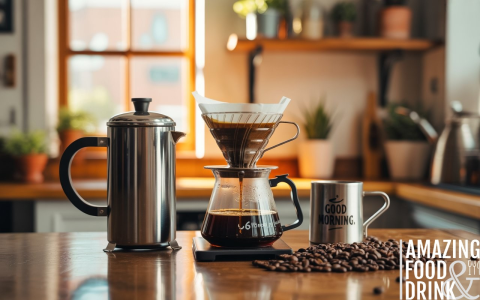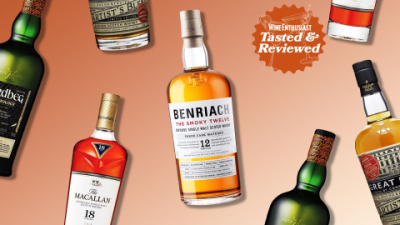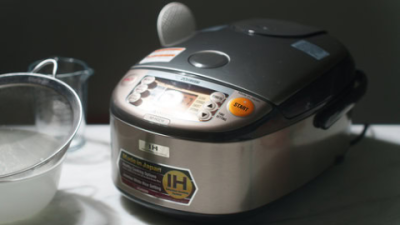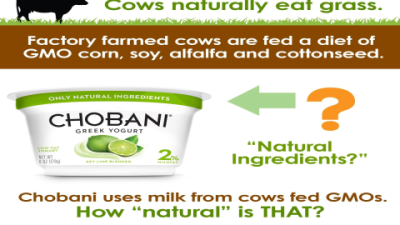1. Espresso vs. French Press: What’s the Real Difference?
Why Grind Size Really Matters
When it comes to coffee, grind size isn’t just a small detail—it’s a big deal. Espresso coffee is ground super fine, almost like powdered sugar, while French press coffee calls for a much coarser grind, more like sea salt. Using espresso grind in a French press often leads to over-extraction, making your coffee bitter and muddy. That happens because fine grounds clog the French press’s mesh filter, slowing water flow and messing with the brew.
Brewing Styles: Pressure vs. Immersion
Espresso machines push hot water through finely ground coffee at high pressure in about 25- seconds. French press, on the other hand, is all about immersion—coffee grounds soak in hot water for a few minutes before you press down the plunger. So, the way each method pulls flavor out of the beans is pretty different. That’s why using espresso coffee in a French press might seem like mixing apples and oranges, but there’s definitely some room to experiment.
2. How to Brew Espresso Coffee in a French Press: Your 6-Step Guide
Step 1: Pick Your Beans and Adjust the Grind
Start with espresso roast beans, but grind them a bit coarser than usual espresso grind—think medium-fine. This helps avoid a gritty, bitter cup.
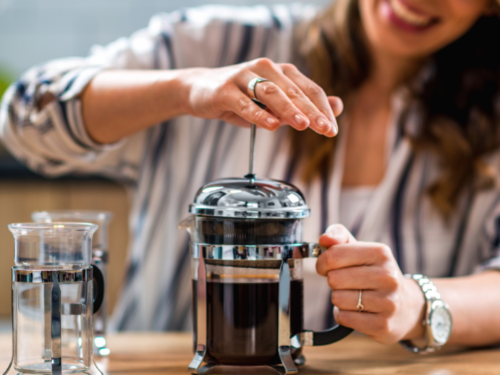
Step 2: Measure Your Coffee Like a Pro
Use about tablespoons of coffee for every ounces of water. This ratio gives you a strong, espresso-like flavor without going overboard.
Step 3: Get the Water Temperature Right
Boil your water, then let it cool for about seconds to hit roughly 200°F (93°C). Water that’s too hot can burn your coffee and make it taste bitter.
Step 4: Pour and Stir Gently
Add half the water to the grounds and stir gently to make sure everything is wet. Then pour in the rest of the water.
Step 5: Let It Steep for 3- Minutes
Timing is key here. Too long, and your coffee might get bitter; too short, and it’ll be weak.
Step 6: Press Slowly and Pour Immediately
Push the plunger down slowly to avoid forcing grounds through the mesh. Serve your coffee right away in a warm cup to keep it tasting fresh.
3. Espresso Machine vs. French Press with Espresso Beans: Which One’s Better?
Flavor Showdown: Intense vs. Smooth
Espresso machines deliver a rich, intense shot topped with crema. Using espresso beans in a French press won’t give you that exact experience, but you’ll get a bold, smoother cup that’s pretty satisfying.
Texture and Sediment: What to Expect
Espresso shots are clean and concentrated. French press coffee usually has more sediment, especially if you use fine espresso grind. Using a slightly coarser grind helps keep your cup cleaner.
Cost and Convenience: What’s the Real Deal?
Espresso machines can be pricey—sometimes hundreds or even thousands of dollars. French presses are budget-friendly, easy to use, and don’t need electricity.
User Experience: What Coffee Lovers Say
Many people love the French press for its simplicity and rich flavor. But if you want authentic espresso, a machine is still the way to go.
Comparison Table: Espresso Machine vs. French Press with Espresso Beans
| Feature | Espresso Machine | French Press (Espresso Beans) |
|---|---|---|
| Flavor | Rich, intense, crema-topped | Bold, smooth, slightly gritty |
| Texture | Clean, concentrated | More sediment, thicker mouthfeel |
| Cost | High (from $200+) | Low (under $50) |
| Ease of Use | Needs skill and maintenance | Simple, easy cleanup |
| Brewing Time | ~ seconds | 3- minutes |
4. Busting Common Myths About Espresso Coffee in a French Press
Myth #1: Espresso Beans Automatically Make Espresso Coffee
Not quite. Espresso beans are just dark roasted coffee beans. It’s the brewing method that makes espresso, not the beans alone.
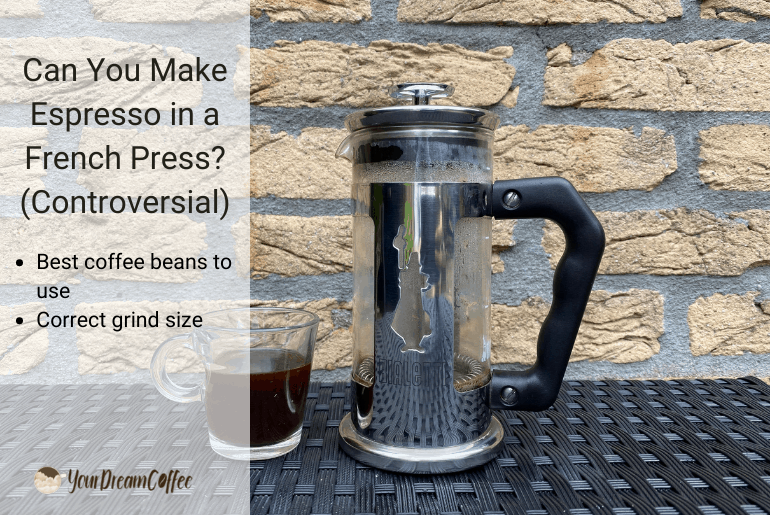
Myth #2: Grind Size Doesn’t Affect Flavor
Actually, it does. Grind size controls how fast flavors are extracted. Too fine and your coffee tastes bitter; too coarse and it’ll be weak.
Myth #3: French Press Can’t Make Strong Coffee
Surprisingly, it can! With the right grind and coffee-to-water ratio, French press coffee can be really bold.
Myth #4: You Need Fancy Gear for Good Coffee
Nope! A decent French press and fresh beans can make a great cup without breaking the bank.
Myth #5: Espresso Coffee in French Press Tastes Just Like Espresso
It won’t. But it can still be delicious and satisfying in its own way.
5. Creative Recipes Using Espresso Coffee Brewed in a French Press
1. Classic French Press Espresso-Style Coffee
Follow the brewing steps and enjoy a bold, straightforward cup.
2. Creamy French Press Espresso Latte
Add steamed milk or your favorite plant-based milk for a cozy, café-style latte.
3. Iced Espresso Coffee
Brew a strong batch, let it cool, then pour over ice for a refreshing pick-me-up.
4. Espresso Coffee Mocktail
Mix chilled espresso coffee with tonic water and a lemon slice for a fun, fizzy twist.
6. Troubleshooting Your French Press Espresso Coffee: Quick Fixes
Problem #1: Bitter Taste
Try a slightly coarser grind and cut your steep time by about seconds.
Problem #2: Too Much Sediment
Press the plunger down slowly and consider filtering your coffee through a paper filter after brewing.

Problem #3: Weak Flavor
Add more coffee or steep a little longer to boost flavor.
Problem #4: Coffee Tastes Burnt or Too Hot
Let your boiled water cool for seconds before pouring it over the grounds.
Problem #5: Plunger Is Hard to Press
Use a coarser grind and press down gently to avoid resistance.
7. The Fascinating History of Espresso and French Press Coffee
Where It All Started
Espresso was born in Italy in the early 1900s as a quick, intense way to make coffee. The French press came about in the 1920s, invented by a Frenchman who wanted a simple brewing method.
How Brewing Methods Changed Over Time
Espresso machines have gotten more advanced, while French press has stayed a favorite for its rustic charm and ease.
Today’s Coffee Culture
Coffee lovers now mix and match methods, trying espresso beans in French presses to discover new flavors.
8. Health and Caffeine: Espresso Coffee in French Press vs. Traditional Espresso
How Much Caffeine Are We Talking?
Espresso shots pack about mg of caffeine per ounce. French press coffee usually has less caffeine per ounce but more overall because you drink more volume.
Health Benefits and Considerations
Both methods deliver antioxidants and a caffeine boost. French press coffee contains more cafestol, which can raise cholesterol if you drink a lot of it.
How to Control Your Caffeine Intake
Adjust how much coffee you use and how long you steep it. For less caffeine, try decaf espresso beans or shorter steep times.
9. Gear Up: Best French Press and Grinder for Espresso Coffee
Choosing the Right French Press
Look for a sturdy glass or stainless steel press with a fine mesh filter for the best results.
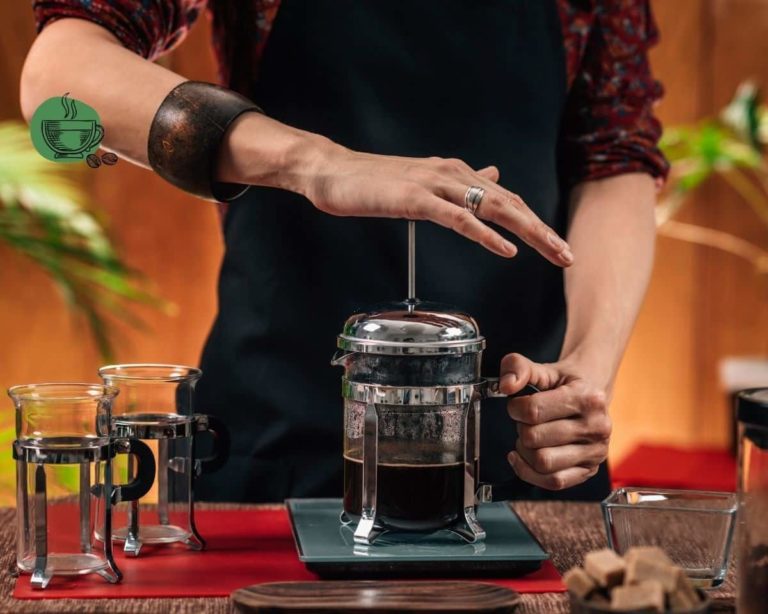
Grinder Choices: Burr vs. Blade
Burr grinders give you a consistent grind size, which is super important when you’re tweaking grind for espresso coffee in a French press.
Keep Your Gear Clean
Regular cleaning helps avoid stale flavors and keeps your coffee tasting fresh.
Budget vs. Premium Picks
You don’t need to spend a fortune—there are plenty of affordable options that work great.
10. Real Stories: Brewing Espresso Coffee in a French Press
Our Team’s Experiment
In 2025, we tried using espresso grind in a French press. The first cup was pretty gritty, but after adjusting the grind size, we got a smooth, rich brew that everyone loved.
What Baristas Say
Most pros agree it’s a fun experiment but not a substitute for a real espresso machine.
User Reviews: Mixed but Mostly Positive
Some people enjoy the boldness and simplicity, while others miss the classic espresso crema. It all depends on what you like!
So, if you’ve got espresso coffee and a French press, don’t hesitate to give it a shot. With a little tweaking, you might just find your new favorite way to enjoy coffee.
